Fusarium Mold: A Fungus Fatal To Cannabis. Is There A Cure?
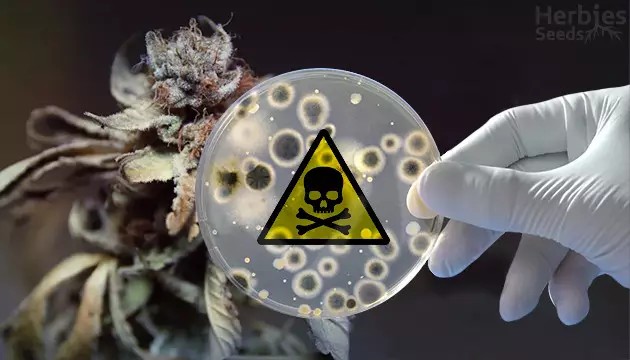
The mysterious name “fusarium” doesn’t reveal much about this type of fungus. It certainly doesn’t imply that it’s capable of destroying an entire harvest of marijuana! Protect your cannabis from a fungal infestation by knowing the symptoms, how to look out for fusarium, and what you can do to prevent it.
Fusarium Mold: What Is It?
Fusarium is a large genus of fungi consisting of hundreds of species and subspecies. Although most of these are harmless, some can be deadly for cannabis plants. Fusarium can lay dormant in soil for years before becoming active, making the fungus very difficult to detect until it’s too late. It’s usually spread by running water and garden tools, and unfortunately (spoiler alert), it can’t be treated. The two main types of fusarium mold disease that can cause you trouble are fusarium wilt and fusarium root rot.
Fusarium Wilt
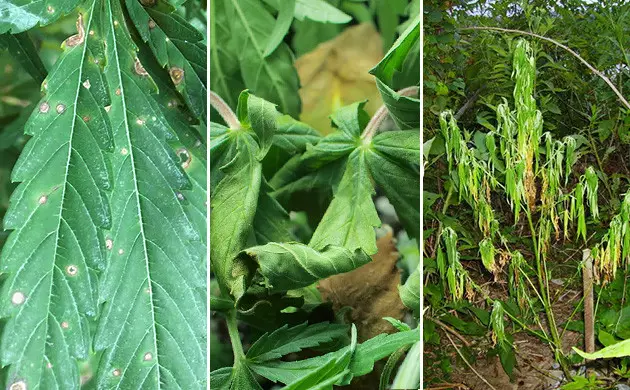
The type of fusarium attributed to wilt is called Fusarium oxysporum. This fungus attacks the xylem, inhibiting the transportation of water and nutrients. The first sign of fusarium wilt in cannabis appears in the lower leaves of the cannabis plant: small, dark, irregular spots that turn yellow-brown will start to cover the green surface. This is followed by the rest of the leaves quickly turning shades of brown and yellow, with the tips curling upward. The stems also meet such a fate. If you’re wondering how to get rid of fusarium wilt… you probably can’t. It’s incredibly vicious, and can spread to the rest of the plant even if you cut off the affected stems.
Fusarium Root Rot
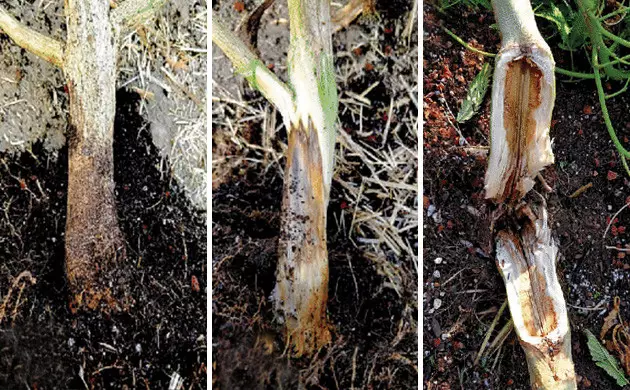
The second type you need to look out for is fusarium root rot, or Fusarium solani. This type of fungus acts differently, attacking the roots first. It makes its home within your plant’s root system, turning them red and rotten, and is usually undetectable until it makes its way up to the stem. The first visible marker of fusarium root rot is when it starts producing a red-brown discoloration on the stem at the soil line. From there, the stem could swell and split open, and the fungus will make its way to the rest of the plant.
The Symptoms Of Cannabis Infected With Fusarium
If you notice red, rotting roots or sudden wilting and dying leaves, you very well may have a fusarium infestation on your hands. Although the symptoms for fusarium wilt and root rot are different, both are equally as deadly for your crop. The easiest signs of a fungal infection to identify are falling leaves and withering of specific branches of your plants. In the case of your marijuana plant showing symptoms of fusarium, it will likely die. It’s best to simply trash and clean everything, then start over.
Fusarium Mold Treatment
As has already been stated, treating fusarium mold is futile. If you’re maintaining your plants and see a sick-looking branch, cut it off as soon as possible and you may be able to salvage the plant. However, once the soil and cannabis plants have been infected with fusarium, everything needs to be cleared out. The soil cannot be reused. Sadly, there is no fungicide for fusarium. However, it is possible to practice prevention. By maintaining high standards of cleanliness, avoiding over-fertilization, and pruning lower leaves, you can maintain conditions that will keep your plants healthy.
How To Keep Fusarium Away From Your Cannabis
Now that you’re aware of the dangers of fusarium, it’s time to talk about prevention. There are several ways you can reduce your chances of encountering this deadly fungus. Read further to learn about prevention methods related to environment, soil, and more.
Monitor Humidity And Temperature
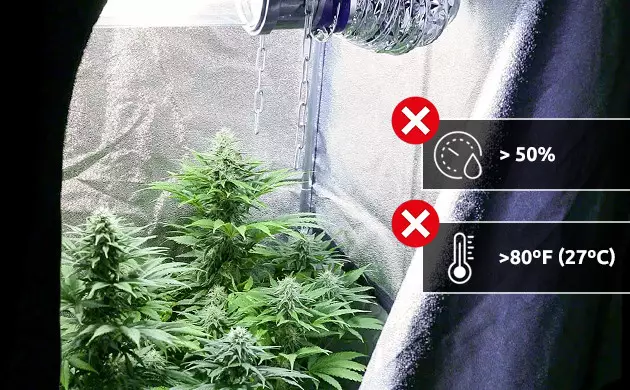
Fusarium loves to grow in warm, moist climates. Unfortunately, many grow setups (like greenhouses) provide the perfect environment for this fungus. With a grow tent, you can control the environment by tweaking factors such as airflow, moisture, and temperature. Avoid pairing temperatures over 80ºF (27ºC) with a relative humidity above 50%. You can monitor humidity levels with a hygrometer and reduce the humidity with a dehumidifier. By also ensuring good airflow, you can minimize your plants’ exposure to any fusarium species that are intolerant to oxygen. Keeping environmental factors under control is the best way to keep your plants happy and healthy.
Don't Plant On Infected Soil
The most common way in which cannabis plants become infected with fusarium is by being planted in infected soil. You won’t know the soil is infected until one of your plants gets sick, since fusarium can lay dormant in soil for years. If that happens, the soil can’t be used to grow cannabis again. Other plants will be fine, because even though the fungus is soil-based, it is also species-specific. Not all types of fusarium attack cannabis, but those that do are lethal.
Don't Use Seeds From Infected Plants
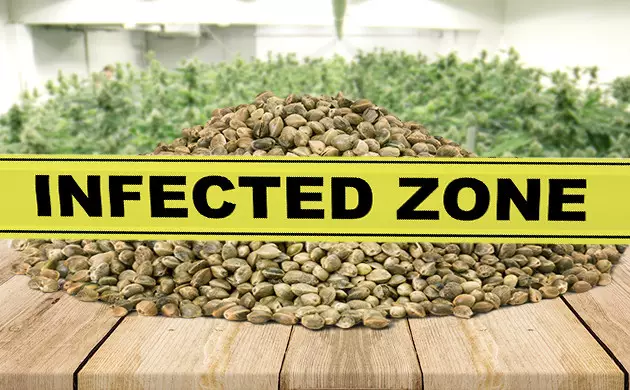
If you have plants that have been affected by fusarium, not even the seeds are salvageable. The sad truth is that the pathogen remains dormant in the seeds and will activate again once the seedling emerges. Fusarium spores are resilient, and will wait for the perfect conditions to develop and infect their next host. You don’t want to have to deal with that again; the best solution is to completely get rid of anything infected.
Use Soil Types With Antifungal Properties

Some types of soil are naturally fungicidal. Clay soils, for example, have fungistatic properties due to high pH levels. Loamy soils also often shelter microbes that inhibit the growth of fusarium. Opting for one of these soil types won’t necessarily stop the fungus on their own, but taking these preventative measures in combination with others can be helpful in keeping fusarium at bay. Growers also report that adding other ingredients like compost, molasses, nettle, and horsetail to soil mixture can create a healthy environment for your plants’ roots.
Use Beneficial Fungi And Bacteria
A healthy environment for your cannabis plant does in fact ideally include fungi – just not fusarium. There are a variety of fungi and bacteria that work together with plants to keep everything happy, healthy, and thriving. For example, mycorrhizae (beneficial fungi) aid in providing disease resistance to the plants. Bacillus pumilus, Bacillus subtilis, and Streptomyces griseoviridis are all bacteria that are beneficial for the growth of your plant. These all make for friendly companions to your cannabis plants, both in fusarium prevention and growth enhancement!
Put Your Compost To Use
Fertilizer and nutrients are essential to a healthy root system, and organic compost and compost teas can protect your plant from any dangers lurking in the soil. Why not start implementing your compost bin into your cannabis growing? In our article Healthy Roots For Healthy Cannabis Plants, we point out the importance of using perlite, vermiculite, peat moss, and compost teas to keep your plants well-fed and protected from fungal infections.
Plant In Containers
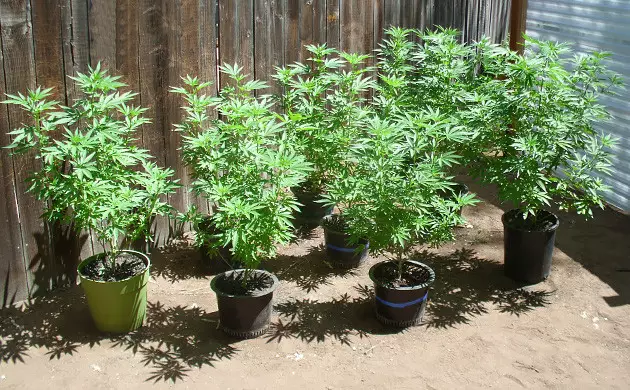
Another way you can control your soil is by planting your cannabis plants in pots, flower boxes, or other containers. Of course, if you’re growing indoors, you’re already using containers to grow your cannabis. Outdoor growing in your garden’s natural soil can lead to uncontrollable factors, and you won’t know if fusarium spores are present until your cannabis plants are infected. If the conditions outside are perfect for growing, you can still harvest a lovely cannabis crop grown in containers instead of the ground.
Maintain A Neutral pH
You can maintain ideal pH levels by using clay soil, as we mentioned earlier. If your current grow’s soil is too acidic, neutralize the pH with dolomite lime or greensand. Not sure what pH your soil should be? Don’t worry – we’ve got the info on the best pH for your cannabis plant. Another tip: avoid overwatering, because excess moisture, whether it’s pHed or not, creates the ideal environment for a fungal invasion, fusarium root rot included. A good rule of thumb is to water your plants only when the top inch (2.5cm) of soil is dry.
Fight Against Fusarium Wilt And Fusarium Root Rot!
It may sound silly to call a fungus a mortal enemy of cannabis growers, but fusarium cannabis is no joke. There’s still no answer to how to get rid of fusarium wilt or fusarium root rot! Given the dire consequences of an infection, it’s smart to practice excellent hygiene and sanitization when growing cannabis. Hopefully you already figured this out, but you should never, ever smoke buds that have been contaminated with fusarium. It can make a person sick if they inhale it, especially if they are immuno-compromised. However, with these tips under your belt, you’ll (hopefully) never have to deal with this fierce fungus!
Herbies Head Shop expressly refuses to support the use, production, or supply of illegal substances. For more details read our Legal Disclaimer.




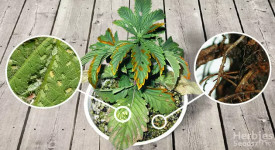




Thank you for leaving a comment for us!
Your feedback will be posted shortly after our moderator checks it.
Please note that we don’t publish reviews that: